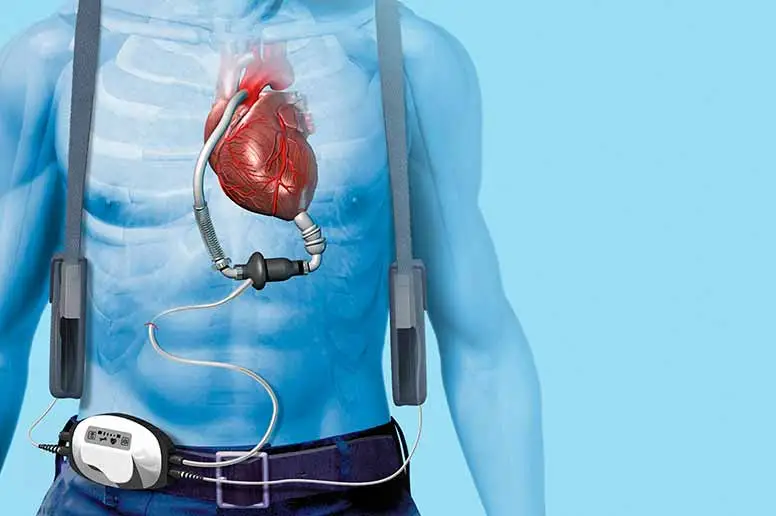LVAD surgeries are related to cardiology, and LVAD stands for Left Ventricular Assist Device. This is a small pump that can help patients by restoring the normal functionality of the heart. In some specific heart diseases, the blood flow is irregular, which can lead to multiple complications. This is especially in the case of people who have been diagnosed with heart failure. In such patients, LVAD is implanted and works as a bridge to a heart transplant. In India, patients suffering from weak hearts can undergo LVAD surgery.
During the surgery, an incision is made in the middle of the chest. This is similar to how it is done in bypass surgery. The rib cage is opened, and the VAD is implanted into the heart. A cable is connected to the pump, which is further attached to the control unit and the battery back. The control unit and the battery pack are outside your body, and the cable passes out of the body through the skin. Currently, the success rate of LVAD surgery is over 70%, and it certainly gives a new lease on life for people suffering from these grave medical conditions.

LVAD surgery is an expensive surgery, and the main factor for that is the cost of LVAD. Until a few years ago, the LVAD used to cost over Rs 40 Lakhs, which has been reduced recently. Presently, LVAD costs Rs 25 Lakh per leading hospital chain in India. However, the surgery cost will be a lot more since you are not just paying for the LVAD. You need to pay for surgery, hospital stay, meals, medicines, and other things. You will also be paying for the diagnostic tests before the LVAD surgery. To help you breathe during the surgery, doctors may also use a ventilator to help you breathe easier. Some of the other factors that will impact the cost of LVAD surgery are listed below.
You must also note that LVAD surgery is covered under insurance coverage. You need to check your coverage and the extent of coverage that applies. It is better to have a critical care health cover that can cover the surgery's full cost.
Q1 – What is the Duration of LVAD Surgery?
A: LVAD surgery is considered to be a major cardiac surgery. You are under general anaesthesia during the whole of the surgery time. The typical duration of the surgery is between 4 hours to 6 hours. After the surgery, you are monitored in the recovery room. You should also note that a heart-lung machine will be used during the surgery, allowing doctors to work on your heart easily. The patient is further monitored in the cardiac ICU for a long time after the surgery.
Q2 – Are There Any Risks associated with LVAD Surgery?
A: Every surgical procedure has its risks and benefits. LVAD surgery also has certain associated risks, and one of the major risks is excessive bleeding or blood clotting. Other risks of LVAD surgery include respiratory failure, heart failure, stroke, kidney failure, infection or device failure. The success rate of the surgery has improved drastically, but the risks will always be there. Before the surgery, the doctor will also teach you about emergencies, system maintenance, alarms and battery replacement.
Q3 – What is the Stay Duration at the Hospital?
A: Since LVAD surgery is considered major surgery, you can expect a long stay in the hospital. For the initial few days, you will be in the cardiac ICU and monitored closely. After that, you are shifted to the normal room, but you must be careful about infections. Typically, a hospital stay can be anywhere between 14 days to 21 days. This varies for each patient as the recovery and rehabilitation for each patient are different.
Q4 – Is it easy to Move Around with LVAD?
A: It is easy to move around with the LVAD. You still must take precautions after the surgery, which is very important. There is no restriction on moving, but you must not do a heavy workout or run. In addition, you must take special precautions during the shower. The controller and the battery must be placed in a bag you get from the hospital. The bag needs to be zipped and closed tightly before you get into a shower.
Q5 – What is the Life Expectancy after LVAD surgery?
A: As per the doctors, LVAD can significantly improve the life expectancy of patients suffering from heart failure. It can easily add 13 to 15 years in life for the patient. In some cases, LVAD is just an interim phase until the heart transplant is conducted, and in other cases, LVAD is implanted permanently. LVAD is better in some cases as there is no dependency on immunosuppressants. In heart transplants, patients need to take immunosuppressants for the rest of their lives. These are not only expensive, but they also impact the kidney.